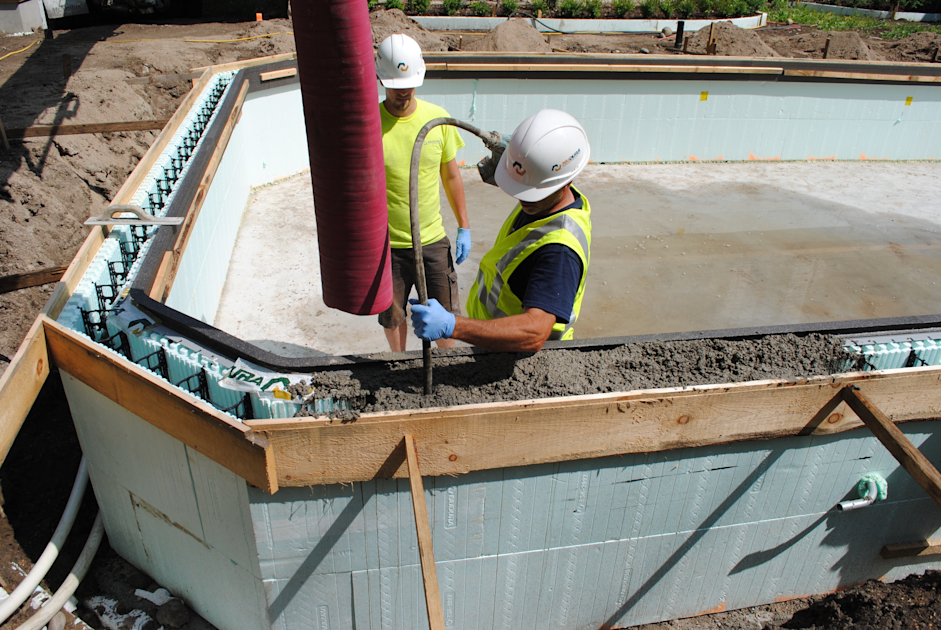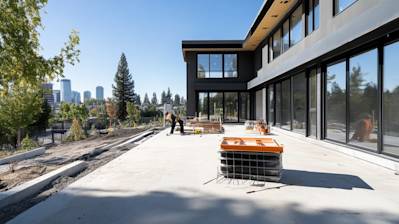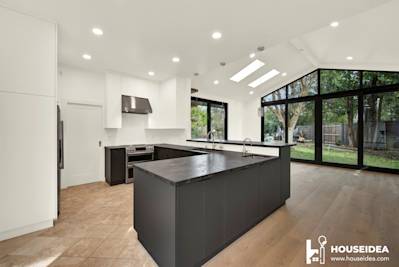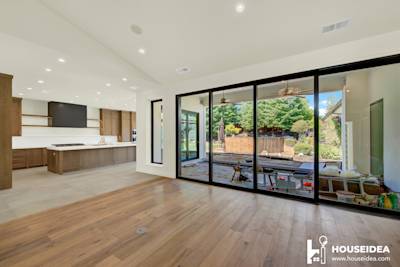Understanding Insulated Concrete Form
To begin with, Insulated Concrete Form (ICF) represents a modern, revolutionary construction method that brings together strength, comfort, and energy efficiency. This construction method utilizes large, pre-formed polystyrene blocks that interlock, creating a form for the structural walls of a building. Once in position, the blocks are then filled with reinforced concrete, creating a robust structure. To better understand this method, let’s delve into why it is becoming the preferred choice in today’s environmentally-conscious building and construction industry.
Key Features of Insulated Concrete Form
This construction technique involves the use of lightweight, hollow blocks that are stacked together, designed to fit like Lego pieces. They are then braced and reinforced with steel bars before pouring concrete into the cavity. Here are the key features of ICF:
- The interlocking modules are made from highly insulating foam.
- Once the concrete sets, it provides a stable, insulated and airtight wall structure.
- The thermostat effect of ICFs ensures that heat is evenly distributed, eliminating cold spots.
- The foam blocks make it easy to cut and shape around utility lines and fixtures.
Components of Insulated Concrete Form
The primary components of an Insulated Concrete Form system include the formwork and the reinforcement. More about them:
Formwork
The formwork is made of extended polystyrene (EPS), and this is what we commonly refer to when we mention "insulated concrete form." This part of the ICF system provides the insulation, shaping, and support for the poured concrete.
Reinforcement
Steel reinforcement bars (rebars) are laid within the formwork before pouring the concrete. The amount and type of rebar used depend on the engineering requirements of the structure being built.
Construction Process with Insulated Concrete Form
The construction process using an insulated concrete form system is quite structured and straightforward. It follows the following general steps:
- Formwork assembly: The EPS formworks are interlocked to create the desired building shape.
- Reinforcement: Steel bars are placed within the formwork at specified locations.
- Concrete placement: High-quality concrete is then poured into the formwork.
- Curing: Allow the concrete to cure fully. This can take anywhere from 24 to 48 hours.
- Finishing: Once the concrete has harden, the building can then be fit out conventionally with plasterboard, render, cladding, or bricks
Wide-Ranging Benefits of Insulated Concrete Form
The benefits of using insulated concrete form building methods are profound and multifaceted.
Energy Efficiency
ICFs have exceptional thermal performance, which helps to reduce the cost of heating and cooling significantly.
Strength and Durability
Concrete walls made with ICFs are some of the strongest, most long-lasting building materials in existence. They can resist natural disasters such as hurricanes, tornadoes, and even earthquakes.
Sound Insulation
The combination of concrete and foam acts as a natural sound barrier, reducing outside noise.
As we strive towards sustainable building practices, insulated concrete form offers an unparalleled blend of efficiency, durability, and comfort. Builders, architects, and homeowners worldwide appreciate the value of this innovative method for constructing homes and commercial buildings. Embracing the insulated concrete form method can undeniably lay the groundwork for a more sustainable and energy-efficient future.
Frequently Asked Questions about Insulated Concrete Form
How are insulated concrete forms manufactured?
Insulated concrete forms (ICFs) are manufactured using two identical, parallel pieces of foam insulation, connected by plastic webs. These are often made from expanded or extruded polystyrene, much like the material used in coolers. These pieces of foam can differ in thickness based on the needs of the project. The webs spaced throughout the formwork hold the pieces together and offer stability during concrete pouring.
Is working with insulated concrete forms difficult?
Working with ICFs is relatively simple and straightforward. The foam panels are lightweight, easy to handle and can be cut to size with standard carpentry tools. Additionally, the forms are designed to interlock much like Lego blocks, making the entire construction process quite efficient. It's always advisable, however, to engage experienced professionals for a seamless ICF construction project.
Can ICFs be customized to different shapes and sizes?
Yes, ICFs are incredibly flexible and can be customized to suit a variety of structural designs. They can be used to construct curved walls, tall walls, and can even be cut down for smaller walls. The combination of plastic webbing and foam insulation allows them to be easily tailored to fit any design requirement.
How do insulated concrete forms enhance energy efficiency?
Insulated concrete forms are known for their impeccable energy efficiency. The foam insulation panels on either side of the concrete form act as a robust barrier, reducing thermal bridging and hence minimizing heat loss. This leads to a remarkable increase in the overall energy efficiency of the structure, resulting in significant savings on utility costs.
Are insulated concrete forms environmentally friendly?
Absolutely, ICFs are considered highly eco-friendly. Firstly, they optimize energy usage, reducing carbon footprint. Secondly, unlike traditional construction materials, ICFs generate minimal construction waste. Lastly, the primary components – EPS foam and steel – are recyclable, making ICFs a sustainable choice for new constructions.
Is it expensive to build with insulated concrete forms?
While the upfront costs of building with ICFs can be higher compared to traditional construction methods, the long-term savings achieved through decreased energy costs, lower maintenance, and increased longevity can more than offset the initial expense. Considering these factors, ICFs can actually prove to be a highly cost-effective construction solution.
Can you remodel or refinish a house built with insulated concrete forms?
No doubt, homes built with ICFs can be remodeled or refinished like any other home. Although adjustments to the interior and exterior finishings are common, structural changes require careful planning due to the reinforced concrete within the foam structural insulation.
Pros and Cons of Insulated Concrete Form (ICF)
Insulated Concrete Form, commonly referred to as ICF is increasingly being adopted in the construction sector due to its remarkable insulation properties and structurally sound designs. However, like every construction method, ICF has its share of advantages and disadvantages. In the sections below, we will explore the pros and cons of Insulated Concrete Form.
PROS
Ease of Use in Construction
One of the major advantages of the Insulated Concrete Form is the simplicity involved in its use. The ICF blocks are easy to stack and can be cut and shaped using standard tools, making the construction process easier, quicker, and less labor-intensive.
- Reduces the need for specialized labour.
- Cuts down construction time significantly.
- Easier to install services such as wiring and plumbing within the formwork.
Improved Energy Efficiency
The Insulated Concrete Form provides an excellent thermal insulation which greatly reduces energy consumption for heating and cooling.
- Can reduce energy costs by up to 70%.
- Keeps indoor temperatures stable, increasing comfort.
- Helps in reducing carbon footprint.
Highly Durable and Resilient
Structures built using Insulated Concrete Form are incredibly durable and resistant to damage from natural disasters like hurricanes, earthquakes, and fires.
- Increased resistance to wind and seismic forces.
- Fire resistant for up to 4 hours.
- Resistant to termite and pest infestation.
CONS:
Higher Initial Cost
Using Insulated Concrete Form can be costlier upfront compared to traditional building methods. This can be a major deterrent for potential users.
- Costs more per square meter/foot to construct.
- Additional expense incurred from specialized trades and engineers.
Limited Design Flexibility
While Insulated Concrete Form allows for a variety of design options, it does not offer the same level of flexibility as wood or steel framing.
- Modifications and alterations after construction are challenging and costly.
- Not suited to intricate architectural designs.
Insulation Thickness Requirements
To meet energy efficiency levels, ICFs must be of a certain thickness, which can reduce room space, and cause problems when matching up with traditional wall thicknesses.
- May result in thicker walls than conventional building methods.
- Requires additional considerations for window and door installation.
In conclusion, when deciding whether to use Insulated Concrete Form in construction, it is important to consider its pros and cons. By understanding both aspects, one can determine if ICF's superior insulation properties and durability outweigh its higher upfront costs and potential design limitations in their specific project.
Summary
Overall, insulated concrete form is a game-changer in sustainable construction. This innovative technology offers incredible energy efficiency and durability, surpassing traditional construction methods. The impact on heating and cooling costs is substantial, helping to lower overall living and maintenance expenses for homeowners.
Moreover, insulated concrete form is not only about energy efficiency but also about living comfort. The superior insulation it provides contributes to a more consistent indoor temperature, and also helps in sound-proofing the home. In addition, its strength can withstand extreme weather events better than most traditional building materials, contributing to greater safety for the home occupants.
Nonetheless, as promising as insulated concrete form may be, it’s essential that construction stakeholders, like architects and builders, understand how to properly design and install it. This includes making construction workers familiar with new techniques and ensuring that building codes account for these materials. With proper knowledge and application, insulated concrete form can revolutionize how we build for the future.
About HouseIdea
Welcome to HouseIdea! We are a Sacramento, CA based company passionate about giving homes a little extra love and creativity. For years, we've been transforming houses into warm, elegant, and inviting homes that reflect their owners' personality and lifestyle. Our team of expert designers and craftsmen adopts a client-centered approach to deliver highly personalized solutions. We are more than just a service; we are your partners in turning your house into your dream haven.
Tags: insulated concrete forms, construction, energy efficiency,



















